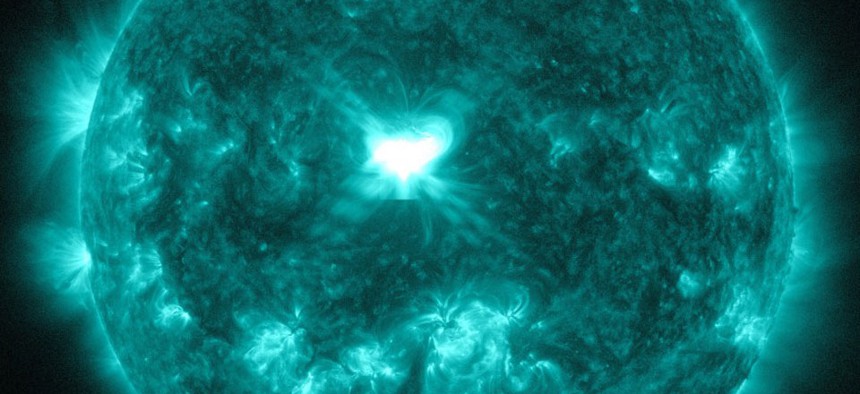Impending Solar Storm Could Cause Tech, Power Grid Disruptions

NASA
Cloudy with a chance of solar radiation.
A solar storm is currently heading toward Earth, and could cause some fluctuations in the U.S. power grid, slight disturbances to GPS satellites and radio transmissions, and rare glimpses of the Northern Lights for some parts of the country.
A powerful solar flare erupted from the middle of the sun Wednesday afternoon, sending a cloud of radiation in Earth's direction, according to NASA's Goddard Space Flight Center. Above is a photo of the flare, captured by NASA's Solar Dynamics Observatory.
The burst of energy produced a solar radiation storm, affecting high-frequency radio communications on Earth, space-weather forecasters said. Experts predict moderate to strong storm levels to last through Sunday, USA Today reports, but they don't expect serious disruptions to the power grid and other technologies.
It's been several years since Earth has seen a solar storm of this size originating from the center of the sun, Tom Berger, director of the National Oceanic and Atmospheric Administration's Space Weather Prediction Center, told the Associated Press.
Solar flares can produce coronal mass ejections, or CMEs—large eruptions of solar wind and magnetized plasma. CMEs can produce geomagnetic storms, which are temporary disturbances in Earth's magnetic sphere. They can also create minor disruptions in high-latitude technologies. Wednesday's flare produced a CME that reached Earth on Thursday night, according to the Space Weather Prediction Center. Another CME is expected to reach Earth on Friday, prompting the center to issue a geomagnetic storm watch (yes, that actually exists).
Satellites and radio transmissions aside, the stormy space weather is good news for humans, which cannot be harmed by solar or geomagnetic storms, thanks to Earth's atmosphere. The Washington Post reports that the intensity of the weekend's storms means that people in northern states such as New York, Michigan, and Wisconsin may be able to see the aurora borealis, an incredible sight usually only visible closer to the North Pole.






